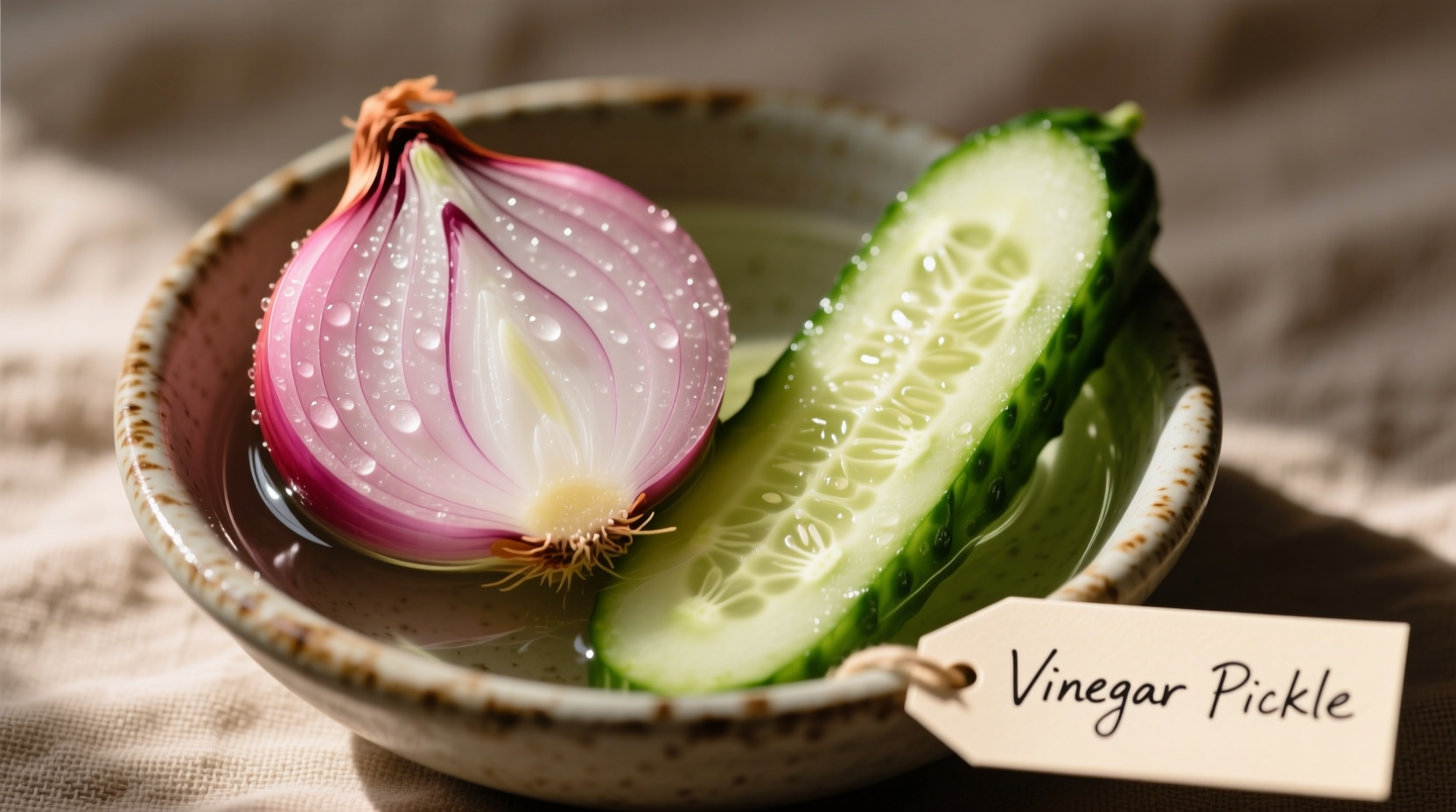Discover how to transform simple vegetables into a vibrant, tangy accompaniment that elevates sandwiches, grilled meats, and salads. This European-inspired vinegar preparation method preserves the natural crunch while developing complex flavors through proper acidification. Unlike quick-pickled versions that compromise texture, our tested technique maintains crispness through precise vinegar ratios and temperature control.
The Science Behind Perfect Vinegar-Pickled Vegetables
Understanding the chemistry of pickling ensures consistently crisp results. The right vinegar concentration creates an environment where beneficial bacteria thrive while preventing spoilage organisms. This balance transforms ordinary vegetables into a probiotic-rich condiment with enhanced shelf life.
| Vinegar Type | Acidity Level | Flavor Profile | Best For |
|---|---|---|---|
| Distilled White | 5-7% | Clean, sharp | Classic pickles, bright appearance |
| Apple Cider | 5-6% | Fruity, mellow | Delicate vegetables, subtle sweetness |
| White Wine | 6-7% | Complex, nuanced | Gourmet applications, refined flavor |
| Red Wine | 6-7% | Robust, earthy | Hearty vegetables, dramatic color |
According to the USDA Complete Guide to Home Canning, maintaining at least 5% acidity in the final brine is essential for safe preservation of non-fermented pickled vegetables. Lower concentrations risk bacterial growth, while higher levels can compromise texture.
Essential Ingredients for Flavorful Results
Selecting quality components makes the difference between ordinary and exceptional pickled vegetables. For onions, red varieties provide striking color contrast while maintaining firm texture. English cucumbers work best due to their lower water content and minimal seeds.
Seasoning combinations transform basic pickles into distinctive creations. Classic French cornichons use tarragon and mustard seeds, while German-style favors dill and peppercorns. For authentic European flavor profiles, incorporate fresh herbs directly into the brine rather than relying solely on dried spices.
Step-by-Step Preparation Process
Preparation phase: Gather sterilized jars, fresh vegetables, and quality vinegar. Wash cucumbers thoroughly and trim ends. Peel onions and slice to uniform 1/8-inch thickness using a mandoline for consistent results.
Brine creation: Combine equal parts vinegar and water (minimum 5% acidity) with 1 tablespoon pickling salt per cup of liquid. Add flavorings like 1 teaspoon mustard seeds, 2 crushed garlic cloves, and fresh dill per pint jar. Heat mixture just until salt dissolves—never boil the vegetables.

Packing technique: Pack vegetables tightly into jars with flavorings. Pour cooled brine over vegetables, leaving 1/2-inch headspace. Remove air bubbles by tapping jars gently. Seal with sterilized lids and rings.
Optimal Storage Timeline for Best Results
Pickled vegetables develop flavor through a predictable maturation process. Understanding this timeline ensures you serve them at their peak:
- 24 hours: Initial tang develops, but flavors remain distinct
- 3-5 days: Flavors begin to meld, optimal crispness
- 1-2 weeks: Peak flavor integration, complex taste profile
- 3-4 weeks: Maximum shelf life while maintaining quality
Refrigeration is essential for vinegar-pickled vegetables not processed through canning. The FDA Food Code specifies that acidified foods with pH below 4.6 must be refrigerated below 41°F (5°C) to prevent potential pathogen growth.
Troubleshooting Common Issues
Certain conditions affect pickling success. Recognizing these context boundaries prevents disappointment:
- Soggy vegetables: Occurs when cucumbers contain excess moisture or brine temperature exceeds 160°F (71°C). Solution: Soak sliced cucumbers in ice water for 30 minutes before packing.
- Cloudy brine: Natural with certain vinegars or hard water. Not harmful but affects appearance. Solution: Use distilled water and filtered vinegar.
- Weak flavor: Insufficient resting time or improper vinegar ratio. Solution: Allow minimum 72 hours before serving.
- Overly sour taste: Vinegar concentration too high or vegetables packed too tightly. Solution: Adjust ratio to 3 parts vinegar to 4 parts water for milder results.
Creative Culinary Applications
Move beyond basic sandwich toppings with these professional techniques:
- Create a quick tartare sauce by finely chopping pickled vegetables with capers and mayonnaise
- Add to grain salads for bright acidity that cuts through rich dressings
- Layer on charcuterie boards for visual contrast and palate cleansing
- Blend into aioli for gourmet burgers and sandwiches
- Chop finely and mix into tuna or chicken salad for added dimension
Nutritionally, vinegar-pickled vegetables retain most of their original nutrients while gaining digestive benefits from the acetic acid. A 1/4 cup serving contains approximately 5 calories, 1 gram of carbohydrates, and provides small amounts of vitamin K and potassium.











 浙公网安备
33010002000092号
浙公网安备
33010002000092号 浙B2-20120091-4
浙B2-20120091-4